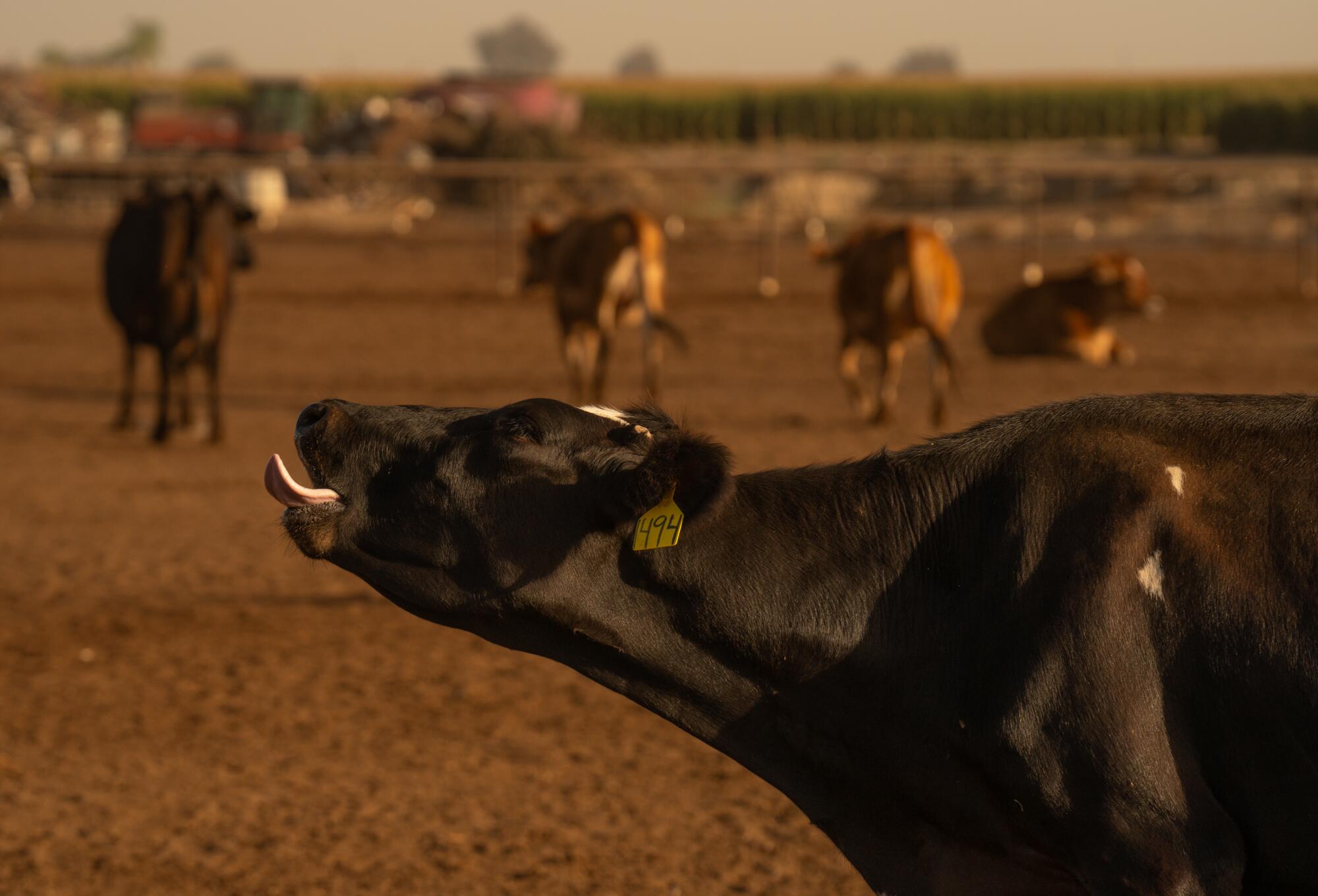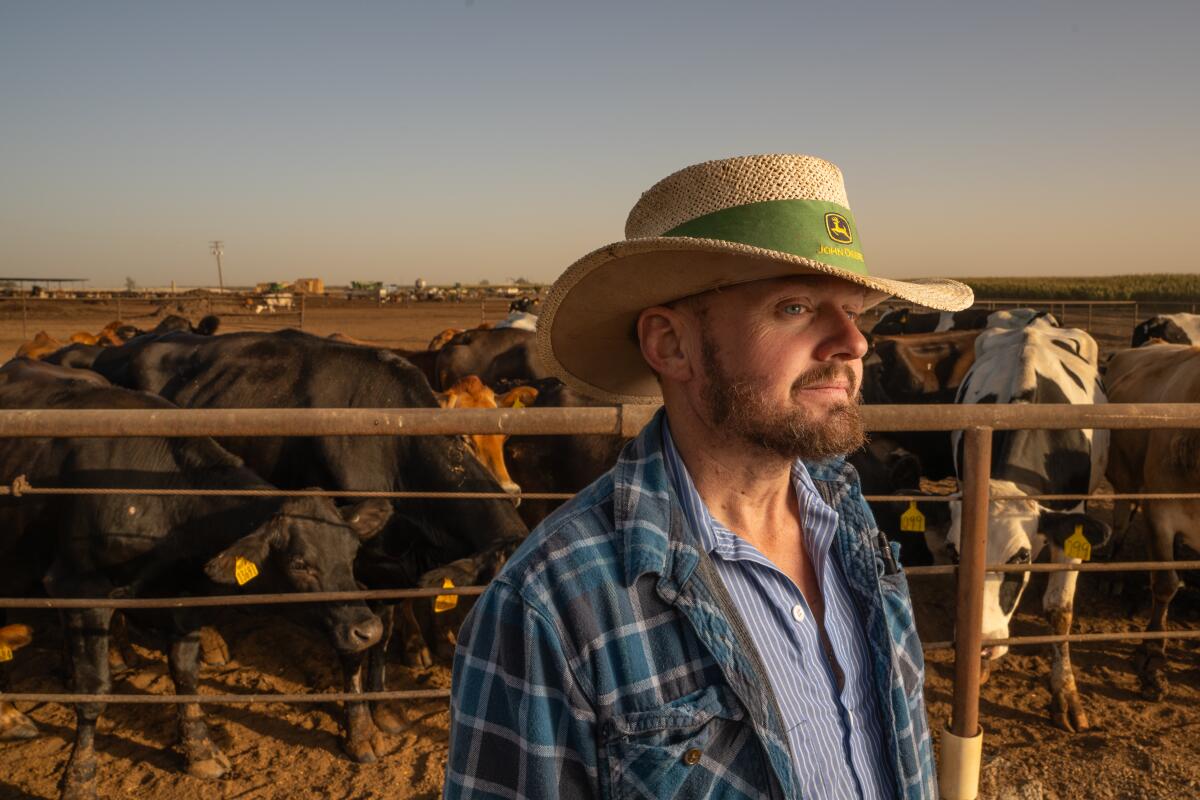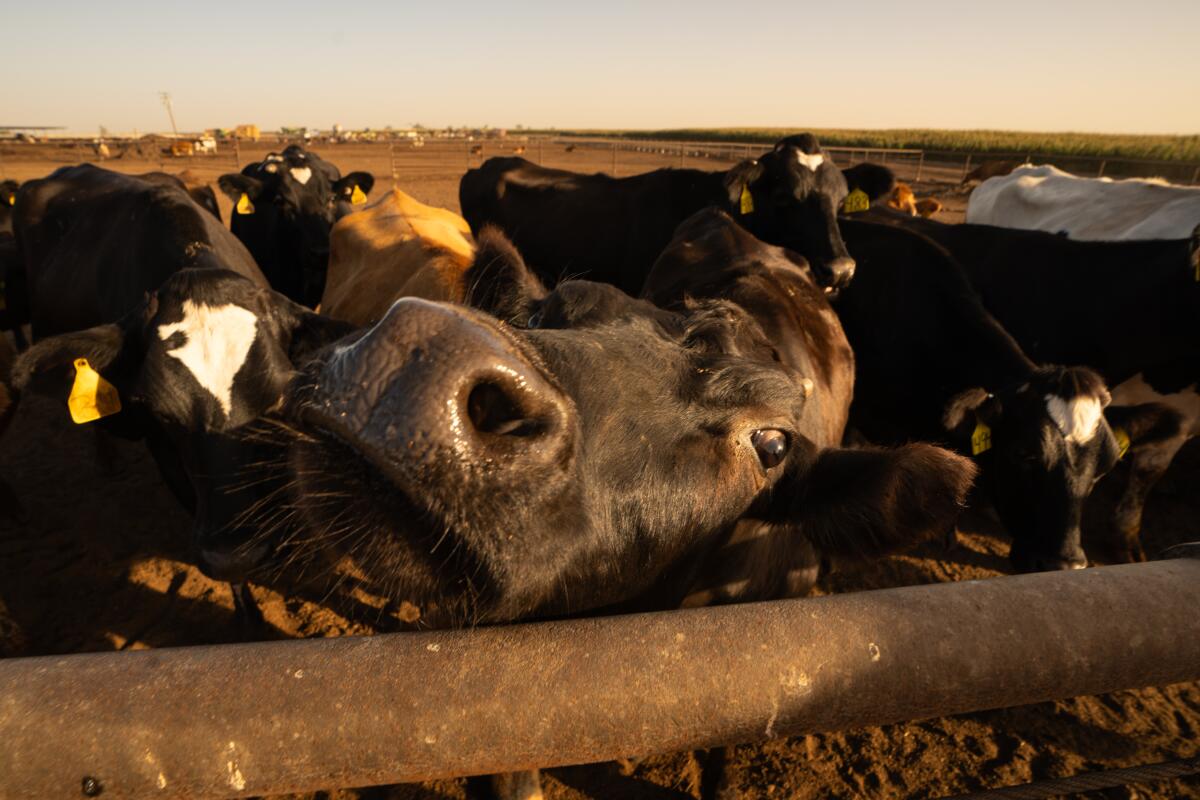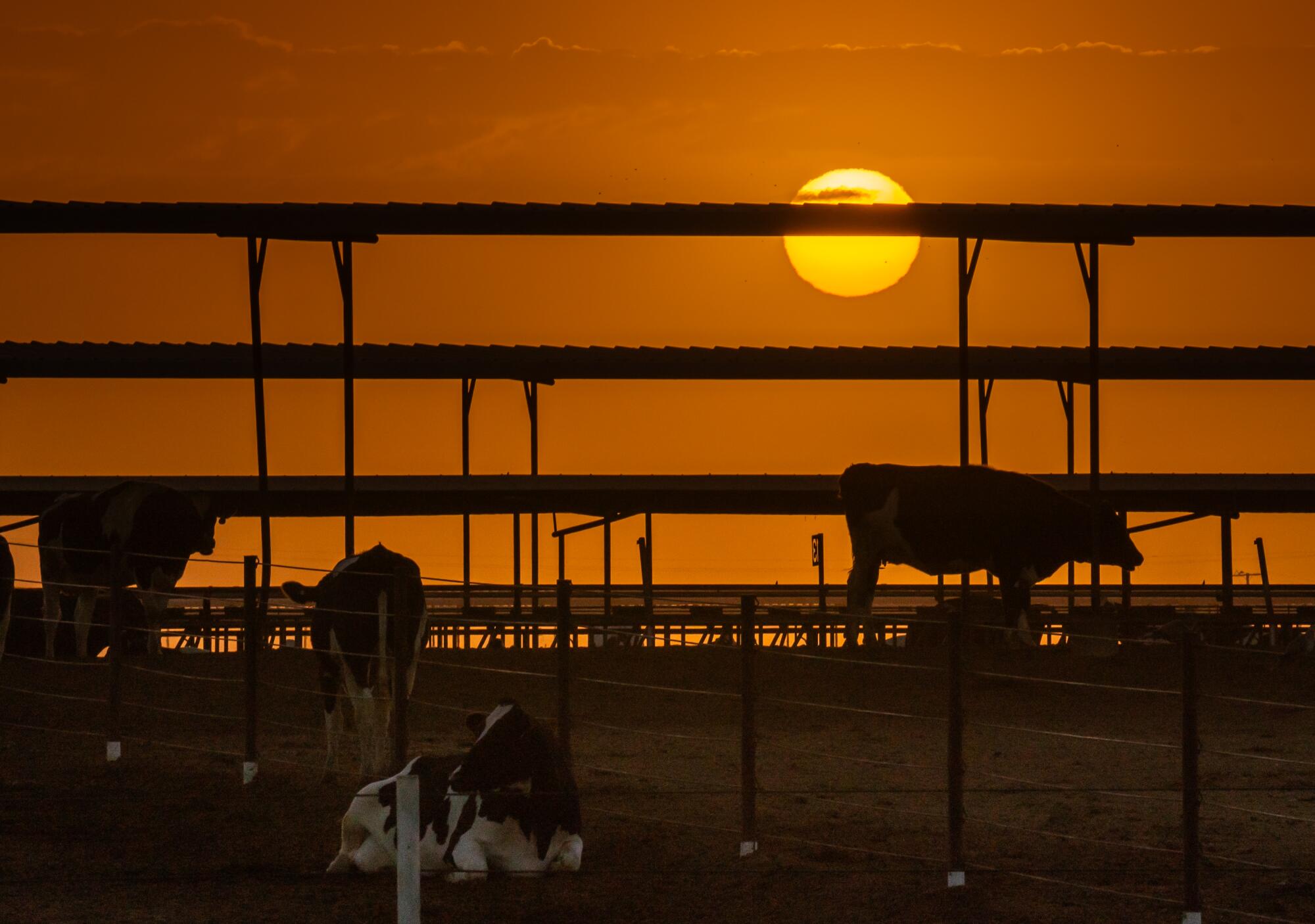There’s a sickness hovering over Tulare County‘s dairy industry.
On a recent 98-degree afternoon, dead cows and calves were piled up along the roadside. Thick swarms of black flies hummed and knocked against the windows of an idling car, while crows and vultures waited nearby — eyeballing the taut and bloated carcasses roasting in the October heat.
Since the H5N1 bird flu virus was first reported in California in early August, 124 dairy herds and 13 people — all dairy workers — have been infected.
And according to dairy experts, the spread of the virus has yet to abate.
Two dead cows lie on the edge of a dairy farm in Tipton, Calif.
“I’m surprised there are that few reported,” said Anja Raudabaugh, CEO of Western United Dairies, a California dairy trade organization, after being told the latest case number was 105. “This thing is not slowing down.”
A similar observation was made by Jimmy Andreoli II, spokesman for Baker Commodities, a rendering company with facilities in Southern California, who said his workers are picking up a surge of dead cows throughout the San Joaquin Valley.
“There’s definitely been an increased number of fallen animals lately, and some of that has got to be attributed to the long, hot summer we’ve had. And some of it, you know, certainly is attributed to the H5N1 virus,” he said, noting that one of his drivers picked up 20 to 30 animals at one farm in one day.
He said at some farms the cows are intentionally being left on the roadside to reduce contamination — preventing further inter-farm spread. At others, the animals are left on-site — but away from live animals and people.

Central Valley dairy farms have been reeling from outbreaks of H5N1 bird flu in recent weeks. The mortality rate among infected cows has been higher than anticipated, industry experts say.
The diseased carcasses are brought to Baker’s rendering site in Kerman, where the bodies are “recycled” and turned into “high protein” animal feed and fertilizer, or rendered into liquids that are then used in fuels, paints, varnishes, lubricants “and all sort of different industrial products.”
He said the Kerman plant is operating normally with no service disruption, even with the heavy influx of diseased cattle. Although due to the large volume of dead animals and “the extra time required for sanitization procedures,” in some areas, pick-ups have shifted from daily to every-other day schedules.”
“All of our customers are being serviced effectively,” he said.
Despite the gruesome scene along the Tipton roadside, John Korslund, a retired U.S. Department of Agriculture veterinarian epidemiologist, said there was probably very little risk to public health in having the animals piled up — even if they were picked at and consumed by buzzards, ravens and flies.
“At death, virus replication stops and putrefaction and heat begins to neutralize live virus,” he said. “Virus will survive on the carcass surface — not for long at 100 degrees — but temperature and acidification pretty rapidly neutralize it in the carcass, at least influenza viruses.”
Raudabaugh said although she and the dairy farmers she represents had been reading about the virus for months before it hit, no one was prepared for the devastation and unevenness with which the virus has struck California’s dairy herds.
She said on some farms, the cows seem virtually unaffected, despite being infected. While on others, the animals are dying in droves. She said she knows of one farm where nearly half the animals died.
She also said some breeds are harder hit than others. For instance, Holsteins seem to suffer more than Jerseys.
“The reason is because Holsteins produce more milk. So they have more volume for the virus to enjoy,” she said, noting research showing the virus’ affinity for mammary tissue.
Asked if the disease was killing them on their hoofs, or if farmers were making tough decisions and euthanizing animals that seemed particularly ill with bacterial pneumonia, mastitis or bloat, she said it was the former.

Continuing H5N1 outbreaks in California dairy herds and reduced milk productivity among recovered cows is causing increasing concern among dairy operators.
She said most of the animals that are succumbing to the virus are young — they are going through their second lactational cycles. (She said most dairy cows will have five or six lactational cycles before they are taken out of production and turned into beef or rendered).
As a result, the farmers are doing what they can to keep these young animals alive “given the extreme rearing and raising and just expenses that go into raising these animals,” she said. “There’s hope that on the other side of the virus, they will come back into production that’s sustainable for the farmer. So it’s definitely a last resort if they are culling them.”
It is unclear if infected dairy cows will recover full production when they enter a new lactational cycle. Observations suggest that production drops significantly in the current cycle, often to 60% or 70%.
She said depression is becoming a bigger and bigger problem for dairy farmers who are struggling with high mortality rates in their cattle herds, as well as the financial burden of the disease.
1

2

1. Brandon Mendonsa, 37, a third generation dairy farmer in Tipton, has lost 28 head of dairy cattle to the H5N1 virus which he called covid for cows. There isn’t a cure for the virus which gives the cattle flu like symptoms and has led to a number of cattle deaths. A Holstein dairy cow at auction gets $2200.00 which would put Mendonsa’s losses at one $60,000. 2. Healthy dairy cattle bask in the morning light on the Mendonsa Farms property in Tipton, CA.
If the cows don’t come back to full production, it could ruin many farmers, she said.
“There’s real fear,” she said.
The U.S. Department of Agriculture has a program to pay back farmers for production loss due to the virus. The program covers the three weeks of production lost by a cow when it is removed from the milking herd to recover, as well as the seven days afterward when production is still low.
But there is currently no program to pay farmers or dairy workers who are affected by the virus, however, which is a concern for infectious disease experts, as well as farmworker advocates who say there is no incentive for dairy workers to report symptoms and isolate for 10 days (the current guidance).
“The majority of dairy workers in California have no protections. Most of them are immigrants. And I would say at least half of them are undocumented,” said Elizabeth Strater, national vice president and director of strategic campaigns for United Farm Workers.
“These are folks that don’t have a particular relationship of trust with state and federal government officials.”
She said dairy work is coveted by immigrants — it’s not seasonal like crop work — and few Americans are hungry for the dangerous and exhausting work the positions require: Two milkings a day (often 15 hours apart) and moving large, unpredictable animals.
“These workers are on the front lines of infectious outbreak, and if they somehow get tested and are tested positive, then they’re going to be looking at something that is financially a disaster,” she said. “Most people in the United States don’t want to miss two weeks of pay, right? Let alone these people who are already … some of the poorest people, and with the least protections. Without a safety net.”
She said her organization and others are trying to inform as many workers as possible.
“We are sharing as much information about how important it is for workers to get their seasonal flu shot this year, even if they don’t always do it,” she said. “But the thing is, that seasonal flu shot does not protect that worker, right? It protects me. It protects you. It protects the rest of the public from a situation in which someone who’s co-infected with two types of influenza exchanges that material” to someone else.
Recombination of H5N1 with a human flu virus — in which the two viruses mix to potentially become a more contagious or harmful virus — is a major concern for public health officials.
According to the U.S. Centers for Disease Control and Prevention, the current public health risk of H5N1 is low, but the agency said it was working with states to monitor people with animal exposures.

The morning sun rises above cows in a Tipton, Calif., dairy farm.
Although the numbers of workers so far reportedly infected with H5N1 remains low, conversations with Tipton residents suggested it’s probably larger than has been reported.
“A lot of people have it,” said a woman working behind the cash register at Tipton’s Dollar General, one of the few stores in this small, agricultural community right off of Highway 99.
The woman declined to provide her name, explaining her husband is a dairy worker in the country illegally in Tulare County; she said his job is not protected or secure, and she was fearful of retribution.
“So far the symptoms seem pretty mild,” she said. “People can keep working.”

